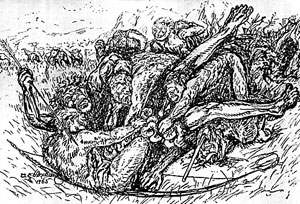According to Veddah and Sri Lankan legends there lived in Sri Lanka a cruel and savage race resembling humans. They were dark in complexion, flat nosed with large heads and short stature, covered with reddish brown hair with large curved claws; they walked upright but had no tails and resembled a bear or an ape. They were great tree climbers and lived in groups of 10-20 in caves or tree tops mainly in the Mahalenama area (presently Yala East) and also in Thamankaduwa, Pomparippu (Puttalam District) and Tanhthirimale areas.
They were called the Nittevo.
It was Hugh Neville, a British explorer who in 1886 described them as above in a publication, the Nittevo of Sri Lanka in the Taprobanian 1886.
 |
| Imaginary drawing by Paul Deraniyagala of hairy hominids eviscerating a fallen vedda with their hands |
Nittevo were considered arch-enemies of the Veddahs and they used to kill each other as they lived in the same forests battling for food and shelter. According to Veddah legends, Nittevo were exterminated by the Veddahs at Mahaenama caves about 250 years ago.
Dr R. L. Spittel who had done a lot of research on Veddahs was of the view that Nittevo were actually a type of bear known as the Sun Bear (Rahuwalaha) who lived in the same forests. Writing in ‘The Loris’, the Ceylon Wildlife Society journal of June 1964 in an article titled ‘Legend of the Nittevo’, he says humans cannot have claws or a body covered with hair.. But the Veddahs claim that they could not mistake a bear for a human and also claim the Nittevo did not have claws or that the body was covered with hair. The word Nittevo was probably derived from “niya atto” (long nailed creatures).
The Yeti of the Himalayas (Abominable Snowman) who is supposed to resemble an ape with a human face is thought by many to be the Tibetan blue bear or the Himalayan brown bear while others believe it is just a legend as no convincing scientific evidence has been found so far.
In the Indonesian island of Flores, a skeleton of a three-foot tall human female was discovered by Australian and Indonesian anthropologists and subsequently six more dwarf skeletons were found. It was assumed that this was an unknown human species and it was named Homo florensiensis or nicknamed the “Hobbit”.
Before the discovery of these skeletons, the inhabitants of these islands told of a race of little people called “Ebu Gogo”, dwarf like creatures that lived in the limestone caves. Dutch explorers who first set foot on Indonesia have mentioned seeing the “Ebu Gogo” but anthropologists regarded these stories as legends till the discovery of these skeletons.
Even today there is Flores Pygmies with some features mentioned earlier. It is believed that Homo floresiensis lived about 12000 -18000 years back while others believe they lived up to 100 years back.
We know of the existence of pygmies in Africa who are around four feet tall. Some of the primitive tribes of Java, Sumatra, Malaya, and Andaman islands are dark and short but do not have claws or body hair. Primatalogist Osman Hill 1940-1950 is of the opinion that Nittevo may have been the Java ape man or Sumatra’s Orang Pendek.
A book published in 1865 by a British army officer by the initials H.A.L. ‘Hunting grounds of the old world’ (Orient Longmans 1885) gives his discovery of the tribe called “Yandi” in the jungles of south west India, who were similar in features to the Nittevo. (Wild men of India by S.Ratananther- Loris: Journal of the Ceylon Wildlife Protection S -December 1965)
In Sri Lanka there are a number of places where the name Nittevo is used e.g. Nittambuwa, Nittahela etc. Mahavamsa or any other ancient chronicles do not mention anything about Nittevo. Very few excavations have been done and they have not discovered any dwarf skeletons. But excavations or entry to Mahalenama which is situated in the Yala east national park is prohibited. Due to the difficult terrain and the war no one could venture up to Mahalenama.
But with the end of the war the relevant authorities may grant permission for excavations. It would be of immense historical and archeological value if excavations are done in and around the Mahalenama caves.
Could any person who knows about Nittevo -enlighten us as to whether their existence was fact or fiction? |


